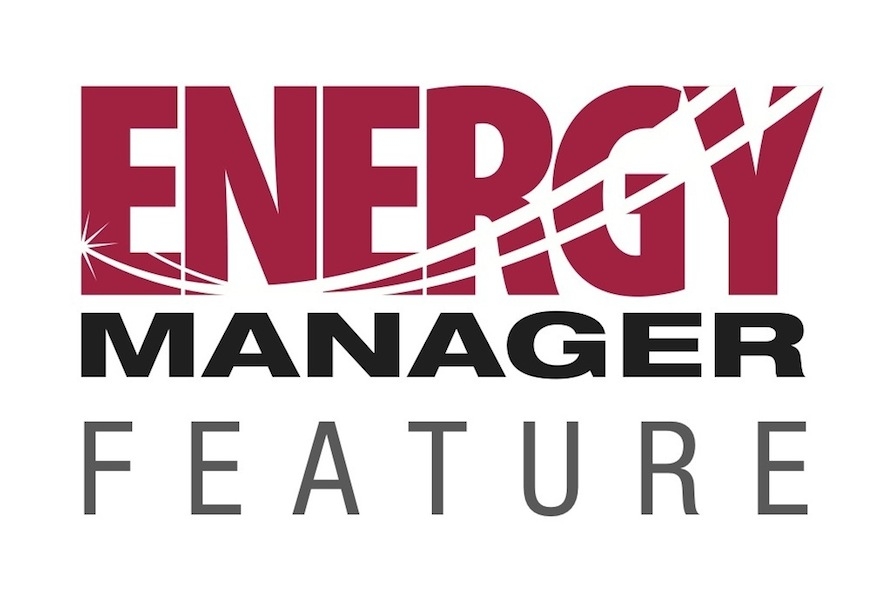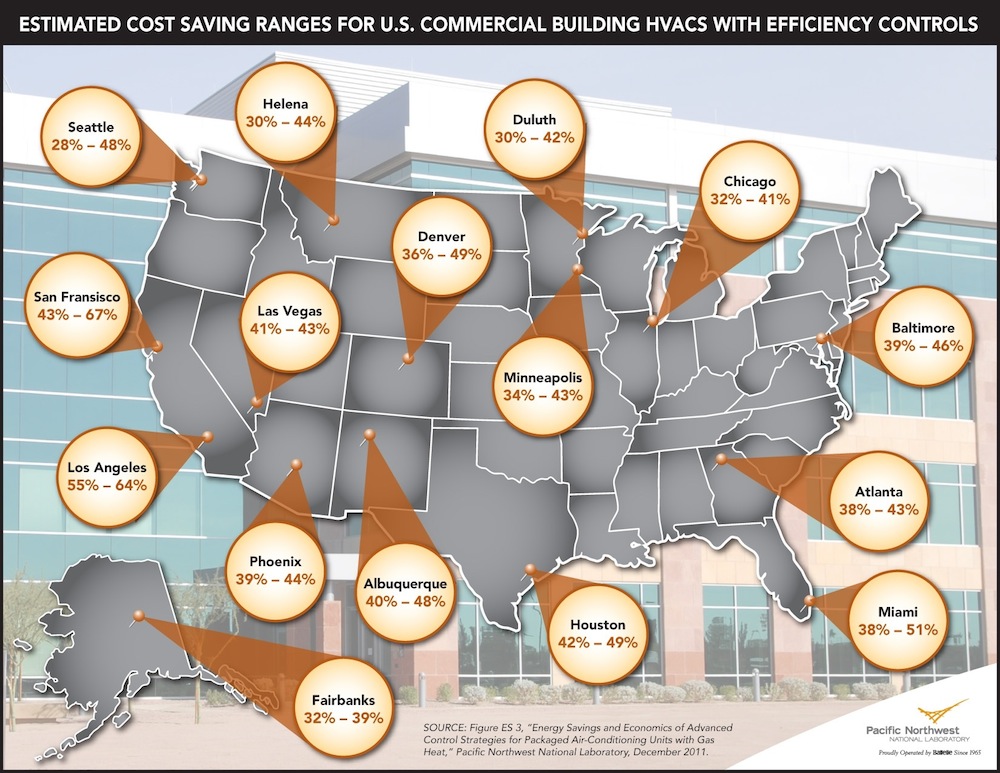
News
FEATURE – PNNL estimates potential HVAC energy savings for commercial buildings
April 24, 2012 - Commercial building owners in the States could save an average of 38% on their heating and cooling bills were they to install a “handful of energy efficiency controls” that make their HVAC systems more energy efficient.
April 24, 2012 By Alyssa Dalton

According to a recent report from the Department of Energy’s (DoE’s) Pacific Northwest National Laboratory, the estimated savings were based on computer modelling and simulation of building energy usage. The controls that could provide these savings are not widely available commercially, but the authors hope their analysis will encourage manufacturers to expand their production.
The report examines options for improving the efficiency of commercial rooftop systems called ‘packaged HVACs’, which combine compressors, fans and heat exchangers into one unit. Packaged HVACs regulate temperatures inside more than 60% of the commercial building floor space in the States, where commercial buildings consume as much energy as about 90 million typical American homes each year. And about 35% of that is used by HVAC systems, which are often poorly maintained or ignored, causing them to run inefficiently.
“The potential savings from adding advanced controls to existing packaged air-conditioners with gas furnaces is enormous,” said PNNL engineer Srinivas Katipamula, who led the study. “The estimated savings depend on local climate and energy prices, and range from a whopping 67% cost savings in San Francisco to a still-substantial 28% in Seattle.”
For the report, Katipamula and his PNNL colleagues considered implementing four different control methods to existing rooftop packaged HVACs:
• Air-side economizers use cool outside air to chill the building instead of creating cool air with the HVAC compressor. Some building codes already require cooling systems to include these, unlike the three other controls examined by the PNNL team.
• Supply fan speed controls slow or speed up the ventilation fan that circulates the building’s air based on whether a desired temperature or amount of fresh air has been reached instead of continually running the fan at full speed.
• Cooling capacity controls run the HVAC compressor at different speeds based on need.
• Demand-controlled ventilation slows or speeds up fans and air intake based on carbon dioxide levels inside the building instead of running ventilation fans at a constant rate.
The study team tracked the effects of using these methods with building energy simulation software EnergyPlus. The software created computer simulations that took into account 15 climate zones in 16 major American cities.
 They studied four types of commercial buildings: small offices of 5500 sf; stand-alone retail buildings of 25,000 sf; strip malls of 22,500 sf; and supermarkets of 45,000 sf. More than 1400 different simulations estimated the potential savings in electricity used to power fans and cooling compressors, as well as the gas used to produce heat. Energy savings were then translated into dollars and cents.
They studied four types of commercial buildings: small offices of 5500 sf; stand-alone retail buildings of 25,000 sf; strip malls of 22,500 sf; and supermarkets of 45,000 sf. More than 1400 different simulations estimated the potential savings in electricity used to power fans and cooling compressors, as well as the gas used to produce heat. Energy savings were then translated into dollars and cents.
Different climates, different controls
In general, the researchers found that installing a multi-speed fan control had the greatest impact on energy savings in hot cities such as Miami. And demand-controlled ventilation created the best possible energy savings in colder cities such as Chicago, Duluth and Seattle.
The team reasoned that because ventilation fans generate some heat when they move, slowing fans with multi-speed fan control in hot climates could reduce the amount of chilling needed. And, in colder climates, they suspect that demand-controlled ventilation prevents unnecessarily sending warm air outside, which then prompts HVAC system to create more warm air to maintain desired temperatures inside.
Big savings
When the research team added up all the numbers, they found the best possible percentage cost savings was 67%, which could occur when all four controls are added to a rooftop packaged HVAC at a small office building in San Francisco. And the minimum percentage cost savings was 28% and could come from adding all four controls to a supermarket in Seattle.
Here are the team’s calculations on each building types’ average cost savings:
• Small office 46%
• Stand-alone retail 43%
• Strip mall 35%
• Supermarket 24%
Their research also showed that Fairbanks, Alaska, could be home to the maximum annual dollar savings for all four building types. Fairbanks could experience savings as high as $52,217 per year at a supermarket and as low as $923 at a small office. The team reasoned that Fairbanks’ dollar-saving advantage was due to its cold climate, which benefits more from the decreased ventilation that occurs with demand-controlled ventilation, as well as the city’s relatively high energy costs.
Here are the average dollar savings each building type could experience by installing all four controls:
• Small office $1496
• Stand-alone retail $10,820
• Strip mall $11,000
• Supermarket $24,200
But savings weren’t limited to cash and energy use. The team also found that a substantial amount of carbon emissions could be avoided when HVAC energy efficiency was increased. As many as sixteen 200-MW coal power plants could sit idle were just half of the nation’s packaged rooftop HVAC units on commercial buildings retrofitted with controls.
Return on investment
Three companies currently manufacturer HVAC controllers, but only one company offers a product with all the control options that resemble the team’s simulations, Katipamula said. To help the manufactures better understand their market, the report also examines potential prices for the controllers and how long it would take for building owners to recoup that cost.
Based on the estimated dollar savings, the team predicted a building owner could recoup his or her investment in a few years. For example, they looked at adding supply fan speed control and demand-controlled ventilation to a supermarket. If that store spends $7523 to equip its HVAC system, it would see a return in three years, while it would take the same supermarket five years to see a return if the controls had a higher price tag of $12,539.
“Our report makes a convincing case for manufacturers to produce more advanced HVAC controllers and for building owners to adopt these energy-saving methods,” Katipamula said.
Next, the team will test the estimated savings in the field. They’re installing controllers into HVAC systems used on two rooftop units at an office building on PNNL’s own campus in Richland, Wash. They’re also planning to install several controllers in various commercial buildings across the United States. Once installed, the controllers will allow the researchers to measure real energy and costs savings.
The PNNL team will also expand its simulations to include more variables, such as looking at heat pumps to calculate potential energy savings. Heat pumps are more common in mild climates than the gas furnaces simulated for this report.
Print this page